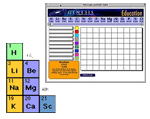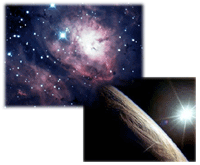    
|
 |
 |
  |
|
 |
| This science module focuses on the relationship
between basic chemistry concepts and the information that
will be returned by the Genesis mission. If you are using
Genesis science modules for the first time, read the User's
Guide thoroughly before you begin. (View User's Guide
as a PDF.)
The Portable Document Format (PDF) is used
to distribute fully formatted, print-quality
documents electronically. The following information
is available to view and print as a PDF file
with Adobe's Acrobat reader. To install the
FREE Adobe Acrobat Reader, visit the Adobe
Web site.
Take a look at other science
modules available. All technical terms
in the science modules are compiled in the Glossary for
easy access.
Technology
Applications are available for this module.
|
|
  |
 |
 Elements
are explored from various perspectives in this science
module. During the exploration, students group elements
by their characteristics much like Dmitri Mendeleev did
in the 19th century. Students will interact with others
by finding out about elements in particular groups. Using
several resources, students will learn how elements are
currently being used in products found in everyday life.
Genesis scientists want to learn about the building blocks
of our solar system. The "Elemental Mysteries for
Genesis Scientists" student text engages students
in the questions these scientists are asking. Finally
students create mathematical models to explain differences
in chemical reactivity among elements. Using their models,
students will interpolate characteristics of a hypothetical
element in the assessment activity. Elements
are explored from various perspectives in this science
module. During the exploration, students group elements
by their characteristics much like Dmitri Mendeleev did
in the 19th century. Students will interact with others
by finding out about elements in particular groups. Using
several resources, students will learn how elements are
currently being used in products found in everyday life.
Genesis scientists want to learn about the building blocks
of our solar system. The "Elemental Mysteries for
Genesis Scientists" student text engages students
in the questions these scientists are asking. Finally
students create mathematical models to explain differences
in chemical reactivity among elements. Using their models,
students will interpolate characteristics of a hypothetical
element in the assessment activity. |
| |
|
|
|
Adobe's Acrobat Reader©

The Portable Document Format (PDF) is used to distribute fully formatted, print-quality documents. |
|
|
|
| |
|
|
|
|
|
|
|
|
|
|
 |
|
|
|
|
 |
| The teacher text contains content
information on atoms, elements, the periodic table, isotopes
and the Genesis mission. Although written for the teacher, this
text could be used in total or in part for students after they
have completed the interactive simulation. The module planning
guide contains information about the entire module. This grid
has been set up to give teachers the tools necessary to teach
the module at a glance. Students
will develop an understanding of the Sun’s solar wind,
the Earth’s magnetosphere, and how the Genesis spacecraft
collected solar wind at L1. |
|
 |
Curriculum
Connections
National Standards Addressed
National
Science Education Standards
Grades 5-8
Science as Inquiry |
- Abilities necessary to do scientific inquiry
- Understandings about scientific inquiry
|
Physical Science |
- Properties and changes of properties in matter
- Transfer of Energy
|
| Science and
Technology |
- Abilities of Technological Design
- Understandings about Science and Technology
|
History and
Nature of Science
|
- Science as a Human Endeavor
- Nature of Science
- History of Science
|
|
Grades 9-12
Science as Inquiry |
- Abilities necessary to do scientific inquiry
- Understandings about scientific inquiry
|
Physical Science |
- Structure of atoms
- Structure and properties of matter
|
| Science and
Technology |
- Abilities of Technological Design
- Understandings about Science and Technology
|
History and
Nature of Science
|
- Science as a Human Endeavor
- Nature of Scientific Knowledge
|
|
|
|
|
|
|
|
|
|
|
|
|
Students learn about the periodic
table by patterning the same approach that Mendeleev used in
the 19th century using an interactive simulation. The simulation
may be completed using element cards without the computer with
Making Sense of the Elements. The interactive simulation can
also be run live off the Web site or downloaded to
student computers with Interactive Simulation. The teacher guide
for each of these contains complete lesson plans for each option. to
student computers with Interactive Simulation. The teacher guide
for each of these contains complete lesson plans for each option.
|
|
|
|
|
 |
|
|
|
|
 |
Students complete reading exercises
to learn more about the development of the periodic table, how
it is used today and what Genesis scientists hope to contribute
to our understanding of the elements.
|
|
|
|
|
 |
|
| | |
 |
 Students
will use the Internet and other sources to locate information
about one element. They will then share the information
about their element with their group (family) and with
the class. Students
will use the Internet and other sources to locate information
about one element. They will then share the information
about their element with their group (family) and with
the class.
|
|
|
|
|
 |
|
|
| |
 |
From the Cosmic
Chemistry: An Elemental Question module, students initially
meet in lab groups to discuss information provided about a
subset of the elements. They finish the assessment individually,
creating a mathematical model to explain differences in chemical
reactivity among these elements, analyzing the process of developing
this model, interpolating from their model the characteristics
of a hypothetical element, and planning a presentations to
their peers on their model. |
|
|
|
|
 |
|
|
|
|
 |
|
|
|
|
|
|
| |
|
 |
|
| |
|
|
| Writers: |
~Greg Rawls, McREL
~John Ristvey, McREL
|
| Graphics: |
~Judy Counley, McREL
|
|
| Special thanks to the following reviewers: |
~Tom Curley, Alta
Loma High School
~Dr. Donna Bogner
~Dr. Don Burnett, California Institute of Technology
~Dr. Marcia Neugebauer, Jet Propulsion Laboratory
~Dr. Don Rapp, Jet Propulsion Laboratory
~Dr. Dorothy Woolum, Jet Propulsion Laboratory
~Alice Krueger, McREL
~Jacinta Behne, McREL
~Greg Rawls, McREL
|
|
|
|
|
|
|
|
|
|
|
|
|
|
|
|

